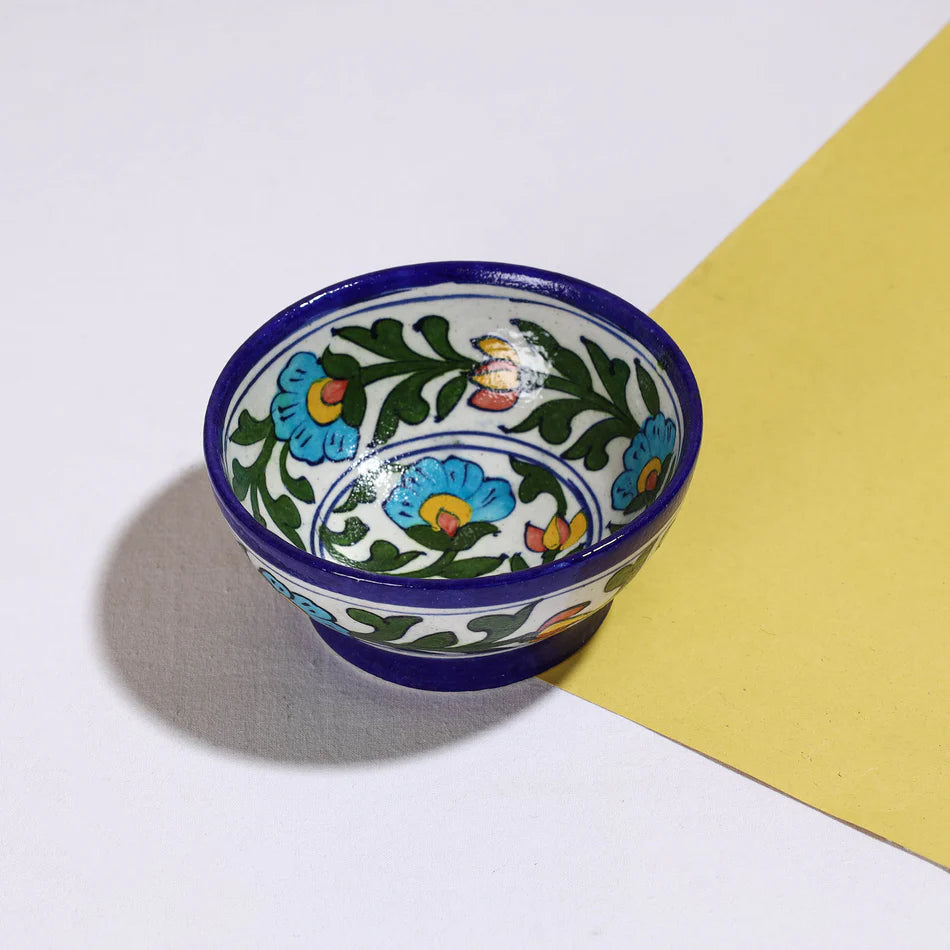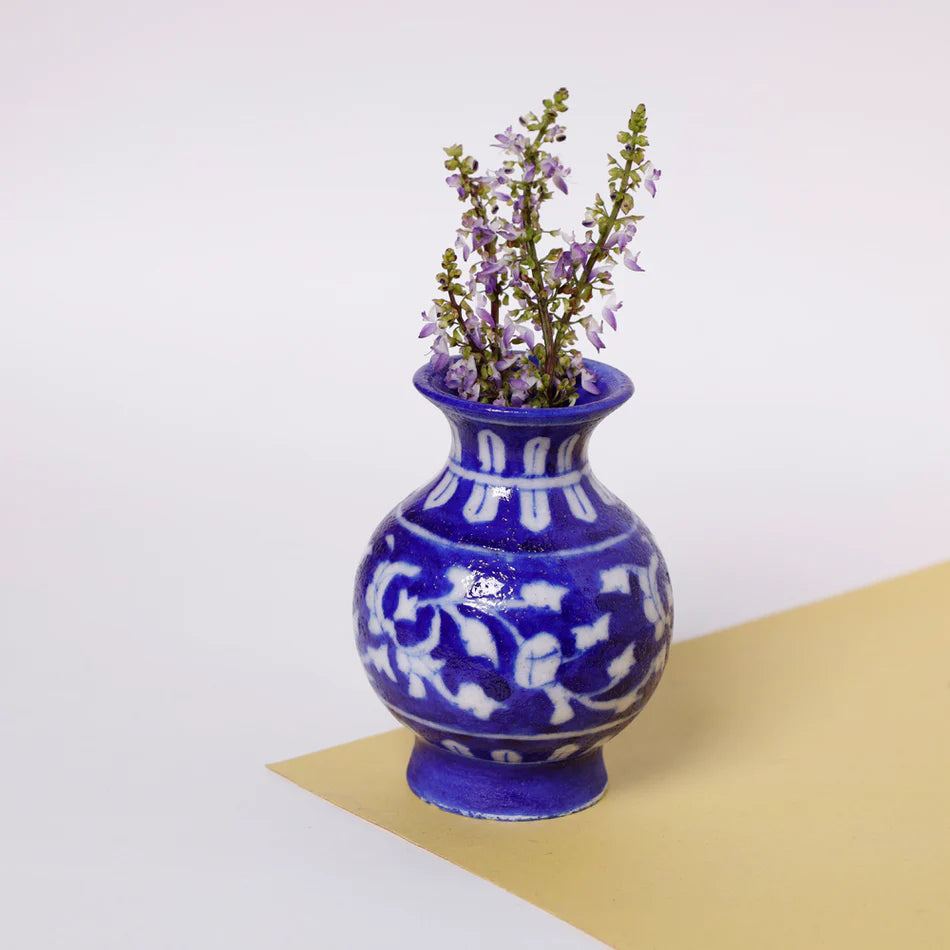Rajasthan – the Land of the Kings – is known for its rich culture and history. Rajasthan’s culture is a blend of various influences of different religions, and travellers which left an indelible mark on the region's art, music, dance, and architecture. The brilliant and colourful art styles of Rajasthan are among its most distinctive cultural features. One such art form is the distinctive form of pottery known as "Blue Pottery." But did you know the interesting story of the Blue Pottery of Jaipur? In this blog let us learn about Blue Pottery history and much more about the famous Blue Pottery of Rajasthan.
What is Blue Pottery
Blue Pottery is a famed traditional craft from Jaipur, Rajasthan It is known for its striking blue colours and beautiful floral and geometric designs. The distinctive feature of Blue pottery is the blue dye used to colour it, which is made from cobalt oxide. Persian and Turkish designs have a significant influence on the Blue Pottery of Jaipur, although it has also evolved its own designs and motifs with time. It is often used to create decorative items such as vases, plates, bowls, tiles and more.

However, Blue Pottery of Rajasthan is originally not from this region and has had an adventurous journey into India.
History and Origin of Blue Pottery
Blue Pottery made its way to India in the 14th century during the early Turkish conquests. This magnificent Turko-Persian pottery-making technology reached East India and eventually flourished under Mughal patronage where artisans introduced Mughal-inspired motifs and designs. However, blue pottery history has more to it.
Maharaja Sawai Jai Singh I founded the city of Jaipur in 1727, in Rajasthan, and extended an invitation to artisans from all across the nation to settle there. Many artists and craftspeople came to Jaipur and settled there because of royal patronage, and lucrative opportunities. Following the customs of his ancestors, Sawai Ram Singh II (1835–1880) established an art school and continued to support artisans.
The journey of Blue Pottery in Jaipur was interesting. When Sawai Ram Singh II took part in a kite flying event in Jaipur he noticed his staff arguing with two brothers. The king was intrigued when he observed that the brothers nearly always succeeded in bringing the royal kites to the ground. He enquired about the brothers' secret. He was informed by them that they were potters by trade and that the same blue-green glass they used to coat their pots were also used to coat their strings. The brothers were invited to stay in Jaipur and teach this distinctive style of glazed pottery at Sawai Ram Singh II's new art school because he was so impressed.
Process of Blue Pottery
Blue pottery of Rajasthan is a unique pottery style that is made from several components. However, the difference between Blue Pottery and conventional pottery is the lack of clay. Powdered quartz stone, powdered glass, borax, gum, and Multani mitti (Fuller's Earth) are the main ingredients used to create Blue Pottery of Jaipur. These components are mixed with water and then they are kneaded into dough. This dough is then made into several shapes by hand or by the potter’s wheel into tableware, vases, tiles and much more.
Designs and Colours used in Blue Pottery of Rajasthan
But the striking feature of Blue Pottery of Rajasthan is the blue dye. Cobalt oxide, a naturally occurring mineral, is used to create this distinct bright blue dye, which is painted onto the pottery before it is fired, giving it a beautiful blue and white finish.
Blue Pottery designs consist of elaborate hand-painted motifs. This craft frequently features floral, bird, and animal motifs as well as geometric and abstract patterns like jaali, paisley, floral designs of lotus, roses or animal designs of peacocks, elephants etc. Blue pottery is not only visually appealing but also highly durable and resistant to scratches and chipping.
Products of Blue Pottery
Today Blue Pottery of Jaipur is famous across the world and people are using it for both tableware and home décor. You can find several blue pottery items on iTokri which are brought to you directly from the artisans in Jaipur, Rajasthan.
Blue Pottery Tableware: From Blue Pottery ceramic serving plates, ceramic triangular tray to ceramic serving bowls you can find several Blue pottery designs on our online store.

Blue Pottery Home Décor: The intricate designs and bright hues of Blue pottery has made it a popular choice for home décor. People like decorating their homes with Blue Pottery wall plates, vases, trays, coasters and much more.

Conclusion
The art of Blue pottery of Jaipur has been passed down through generations of artisans in Rajasthan and has become an integral part of the state's cultural heritage. It is widely regarded as one of the most beautiful and unique forms of pottery in the world. Our endeavour at iTokri is to give a platform to these wonderful artisans so that their handcrafted products can reach a larger audience easily.
Frequently Asked Questions - FAQs on Blue Pottery of Jaipur
Who introduced Blue Pottery in Rajasthan?
Along with the early Turkish conquest, a group of Persian artisans who travelled to the city of Jaipur in the early 19th century brought blue pottery to Rajasthan. To assist in reviving the region's art and craft, they were asked by Maharaja Sawai Ram Singh II, the then ruler of Jaipur.
Which city in Rajasthan is famous for Blue Pottery?
The capital city of Jaipur in Rajasthan is famous for its Blue Pottery. The striking cobalt blue dye used to colour the pottery gives it the moniker "Blue Pottery." Blue Pottery designs can be elaborate floral motifs, animals or even abstract.
What is the famous pottery of Rajasthan called?
Blue Pottery is the most famous pottery in Rajasthan which is known for its unique blue hues. It is also called the no clay pottery, which has an origin in the Turko-Persian region.
Why is it called Blue Pottery?
Blue Pottery of Jaipur is known for its striking blue colours which gave its name. Unlike the several blue and white Eurasian pottery kinds, Blue Pottery is distantly related to Islamic pottery crafts in terms of shapes and design.
Does the colour of Blue Pottery wash off?
The cobalt blue colour used in Blue Pottery of Rajasthan doesn’t wash off or develop any cracks.
Which kind of colour is used in Blue Pottery of Rajasthan?
Cobalt ores are what give Blue pottery designs their characteristic blue hues. These were limited-edition materials at the time and were imported from Persia.
Can I use Blue Pottery plates and bowls in the microwave?
Blue pottery plates and bowls are microwave-safe and dishwasher-safe.
 Verified Purchase
Verified Purchase



















































Leave a comment (all fields required)